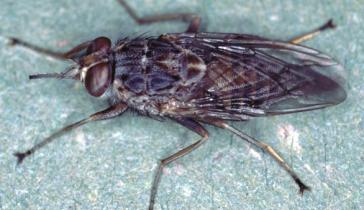The images coming out of sub-Saharan Africa are deeply disturbing: grief-stricken farmers looking on in horror at their weakened cattle reduced to skin and bones.
But the cattle aren’t starving. They’ve been infected with the deadly Trypanosome blood parasite carried by the tsetse fly.
A subsistence farmer may pride himself on owning one or two head of cattle. The animals are a great boon not only for milk or beef production, but also for hauling and plowing—the original farm tractor. But once bitten by the nearly ubiquitous tsetse, those cattle and the farmer’s hopes can be devastated virtually overnight.
The single-celled Trypanosome parasite, the same parasite that causes sleeping sickness in humans, divides within the blood every six hours. In a matter of days, the poor animal is terminally diseased and the characteristic wasting process, known in Africa as Nagana, starts reducing it to a living skeleton.
As a result of trypanosome, in the one-third of sub-Saharan Africa where the tsetse fly is most prevalent, farming has to be done entirely without livestock, by hand—a huge sacrifice in agrarian productivity.
Scientists have long been aware of the human costs of the parasite but hope for a solution has been painfully elusive. Until now: today’s CRISPR-driven genetic engineering technology may finally be turning the tide.
A Cambridge-educated gene researcher now at Hunter College in New York, Dr. Jayne Raper, supervises a team investigating why some primates in Africa are able to resist the parasite, at least partially. Baboons, which have thrived in Africa for eight million years, are totally resistant.
After years of painstaking research, Dr. Raper—using CRISPR—was able to find, mark, cut and abstract the genetic factor responsible for the baboon’s unusual resistance. News of her success rocketed through the world of specialists in the Trypanosome problem.
Proof of concept studies involved transferring the genomic factor to mice and then infecting “protected” and “unprotected” mice with the Trypanosome parasite. The breakthrough came. The blood of the genetically protected mice remained completely clear.
Dr. Raper’s team, cooperating with scientists at the International Livestock Research Institute in Nairobi, Kenya, have begun experiments to transfer the baboon’s genetic resistance to cattle, inseminating mothers to produce offspring with the desired trait—and the ability to pass it on to their own offspring.
It’s a long path—from the lab to research breeding, to a stock of African cattle with African immunity. The project will take years, substantial funding, and careful monitoring. But the result could usher in a new world of agricultural revival—an unprecedented increase in productivity for tens of millions of poor African farmers.




